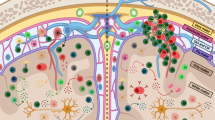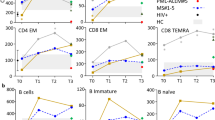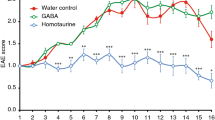Abstract
In this ‘double-blind’, randomized, placebo-controlled phase II trial, we compared an altered peptide ligand of myelin basic protein with placebo, evaluating their safety and influence on magnetic resonance imaging in relapsing–remitting multiple sclerosis. A safety board suspended the trial because of hypersensitivity reactions in 9% of the patients. There were no increases in either clinical relapses or in new enhancing lesions in any patient, even those with hypersensitivity reactions. Secondary analysis of those patients completing the study showed that the volume and number of enhancing lesions were reduced at a dose of 5 mg. There was also a regulatory type 2 T helper-cell response to altered peptide ligand that cross-reacted with the native peptide.
This is a preview of subscription content, access via your institution
Access options
Subscribe to this journal
Receive 12 print issues and online access
$209.00 per year
only $17.42 per issue
Buy this article
- Purchase on Springer Link
- Instant access to full article PDF
Prices may be subject to local taxes which are calculated during checkout


Similar content being viewed by others
References
Martin, R., McFarland, H.F. & McFarlin, D.E. Immunological aspects of demyelinating diseases. Annu. Rev. Immunol. 10, 153–187 (1992).
Steinman, L. Multiple sclerosis: A coordinated immunological attack against myelin in the central nervous system. Cell 85, 299– 302 (1996).
Noseworthy, J.H. Progress in determining the causes and treatment of multiple sclerosis. Nature 399, A40–47 ( 1999).
Ebers, G.C. et al. A full genome search in multiple sclerosis. Nature Genetics 13, 472–476 ( 1996).
Sawcer, S. et al. A genome screen in multiple sclerosis reveals susceptibility loci on chromosome 6p21 and 17q22. Nature Genet. 13 , 464–468 (1996).
The Multiple Sclerosis Genetics Group. A complete genomic screen for multiple sclerosis underscores a role for the major histocompatibility complex. Nature Genet. 13, 469– 471 (1996).
Krogsgaard, M. et al. Visualization of myelin basic protein [MBP] T cell epitopes in MS lesions using a monoclonal antibody specific for the human histocompatibility leukocyte antigen HLA DR2 MBP 95–99 complex. J. Exp. Med. 191, 1395–412 ( 2000).
Oksenberg, J.R. et al. Selection for T cell receptor Vb-Db-Jb gene rearrangements with specificity for a myelin basic protein peptide in brain lesions of multiple sclerosis. Nature 362, 68– 70 (1993).
Ota, K. et al. T cell recognition of an immunodominant myelin basic protein epitope in multiple sclerosis. Nature 346, 183– 187 (1990).
Martin, R. et al. A myelin basic protein peptide is recognized by cytotoxic T cells in the context of four HLA-DR types associated with multiple sclerosis . J. Exp. Med. 173, 19– 24 (1991).
Steinman, L., Waisman, A. & Altmann, A. Major T cell responses in multiple sclerosis. Mol. Med. Today 1, 79–83 (1995).
Evavold, B.D. et al. Separation of T helper 1 clone cytolysis from proliferation and lymphokine production using analog peptides. J. Immunol. 150, 3131–3140 (1993).
Kuchroo, V. et al. A single TCR antagonist peptide inhibits experimental autoimmune encephalomyelitis mediated by a diverse T cell repertoire. J. Immunol. 153, 3326–3336 ( 1994).
Hemmer, B., Stefanova, I., Vergelli, M., Germain, R.N. & Martin, R. Relationships among TCR ligand potency, thresholds for effector function elicitation, and the quality of early signaling events in human T cells. J. Immunol. 160, 5807–5814 ( 1998).
Karin, N., Mitchell, D., Ling, N., Brocke, S. & Steinman, L. Reversal of experimental autoimmune encephalomyelitis by a soluble variant of a myelin basic protein epitope: T cell receptor antagonism and reduction of Interferon-γ and TNF-α production. J. Exp. Med. 180, 2227–2237 (1994).
Gaur, A. et al. Amelioration of relapsing experimental autoimmune encephalomyelitis with altered myelin basic protein peptides involves different cellular mechanisms . J. Neuroimmunol. 74, 149– 158 (1997).
Stark, S.R. et al. Double-blind randomized placebo control parallel-group evaluation of the safety and effect on immunological parameters of the altered peptide ligand MSP771 in patients with MS. Multiple Sclerosis S, 596 (1999).
Crowe, P.D., Qin, Y., Conlon, P.J. & Antel, J.P. NBI 5788, an altered MBP83–99 peptide, induces a Th2-like immune response in multiple sclerosis patients. Ann. Neuro–. In Press.
Bielekova, B. et al. Preferential expansion of autoreactive T lymphocytes from the memory T- cell pool by IL-7. Brain Pathol. 9, 69–92 (1999).
Goris, A. et al. Analysis of an IFN-gamma gene (IFN-γ) polymorphism in multiple sclerosis in Europe: effect of population structure on association with disease . J. Interferon Cytokine Res. 19(9), 1037 –1046 (1999).
Arnason, B. Immunological therapy of MS. Ann. Rev. Med. 50, 291–302 (1999).
Steinman, L. Escape from horror autotoxicus: The pathogenesis and treatment of autoimmmunity . Cell 80, 7–10 (1995).
Steinman, L. & Conlon, P. Viral damage and the breakdown of self-tolerance. Nature Med. 3, 1085–1087 (1997).
Panitch, H.S. et al. Treatment of MS with gamma interferon: Exacerbations associated with activation of the immune system. Neurology 37, 1097–1103 (1987).
Hermans, G. et al. Cytokine profile of MBP-reactive T cells in MS and healthy individuals. Ann. Neurol. 42, 18– 27 (1997).
Navikas, V. et al. Augmented expression of TNFα and lymphotoxin in mononuclear cells in multiple sclerosis and optic neuritis. Brain 119, 213–223 (1996).
Hofman, F.M., Hinton, D.R., Johnson, K. & Merrill, J.E. TNF identified in MS brain. J. Exp. Med. 170, 607–612 (1989).
Cannella, B. & Raine, C.S. The adhesion molecule and cytokine profile of MS lesions. Ann. Neurol. 37 , 424–435 (1995).
Traugott, U. & Lebon, P. Multiple sclerosis: Involvement of interferons in lesion pathogenesis. Ann. Neurol. 24, 245–251 (1988).
Luchinetti, C.F., Bruck, W., Rodriguez, M. & Lassmann, H. Distinct patterns of multiple sclerosis pathology indicates heterogeneity in pathogenesis. Brain Pathology 6, 259– 274 (1996).
Brocke, S. et al. Treatment of experimental encephalomyelitis with a peptide analogue of myelin basic protein. Nature 379, 343–346 (1996).
Yu, M., Johnson, J.M. & Tuohy, V.K. A predictable sequential determinant-spreading cascade invariably accompanies progression of EAE: A basis for peptide-specific therapy after onset of clinical disease. J. Exp. Med. 183, 1771–1778 (1996).
Windhagen, A. et al. Modulation of cytokine patterns of human autoreactive T cell clones by a single amino acid substitution of their peptide ligand. Immunity 2, 373–380 ( 1995).
Valli, A. et al. Binding of myelin basic protein peptides to human histocompatibility leukocyte antigen class II molecules and their recognition by T cells from multiple sclerosis patients. J. Clin. Invest. 91, 616–28 (1993).
Comi, G. & Filippi, M. The effect of Copaxone® on disease activity as measured by cerebral MRI in patients with RRMS: a multi-center, randomized double blind, placebo controlled study extended by open label treatment . Neurology 52, A289 ( 1999).
Aharoni, R., Teitelbaum, D., Arnon, R. & Sela, M. Copolymer 1 acts against the immunodominant epitope 82–100 of myelin basic protein by T cell receptor antagonism in addition to major histocompatibility complex blocking. Proc. Natl. Acad. Sci. USA 96, 634–9 (1999).
Duda, P.W., Schmied, M.C., Cook, S.L., Krieger, J.I. & Hafler, D.A. Glatiramer acetate (Copaxone®) induces degenerate, Th2-polarized immune responses in patients with multiple sclerosis. J. Clin. Invest. 105, 967–976 (2000).
Vandenbark, A.A. et al. Treatment of multiple sclerosis with T-cell receptor peptides: Results of a double-blind pilot trial. Nature Med. 10, 1109–1115 (1996).
Kotzin, B. et al. Preferential TCR beta chain variable gene use in MBP reactive T cell clones from patients with MS. Proc. Natl. Acad. Sci. USA 88, 9161–9165 ( 1991).
Collins, D.L., Neelin, P., Peters, T.M. & Evans, A.C. Automatic 3D intersubject registration of MR volumetric data in standardized Talairach space. J. Computer Assisted Tomography 18(2) , 192–205 (1994).
Zijdenbos, A., Forghani, R. & Evans, A. in Proceedings of the First International Conference on Medical Image Computing and Computer-Assisted Intervention (MICCAI) 439–448 (Springer. Verlag, Berlin, 1998).
Acknowledgements
The support of many investigators with Novartis Pharma is acknowledged, including R. Jackson, D. Murphy, G. Karlsson, H. Faleck, L. Kramer and T. Staehlin.
Author information
Authors and Affiliations
Corresponding author
Rights and permissions
About this article
Cite this article
Kappos, L., Comi, G., Panitch, H. et al. Induction of a non-encephalitogenic type 2 T helper-cell autoimmune response in multiple sclerosis after administration of an altered peptide ligand in a placebo-controlled, randomized phase II trial. Nat Med 6, 1176–1182 (2000). https://doi.org/10.1038/80525
Received:
Accepted:
Issue Date:
DOI: https://doi.org/10.1038/80525
This article is cited by
-
Auto-antigen and Immunomodulatory Agent–Based Approaches for Antigen-Specific Tolerance in NOD Mice
Current Diabetes Reports (2021)
-
Antigen-specific therapeutic approaches for autoimmunity
Nature Biotechnology (2019)
-
Beyond the Magic Bullet: Current Progress of Therapeutic Vaccination in Multiple Sclerosis
CNS Drugs (2018)
-
A Novel Aza-MBP Altered Peptide Ligand for the Treatment of Experimental Autoimmune Encephalomyelitis
Molecular Neurobiology (2018)
-
Neuroimmunotherapies Targeting T Cells: From Pathophysiology to Therapeutic Applications
Neurotherapeutics (2016)



